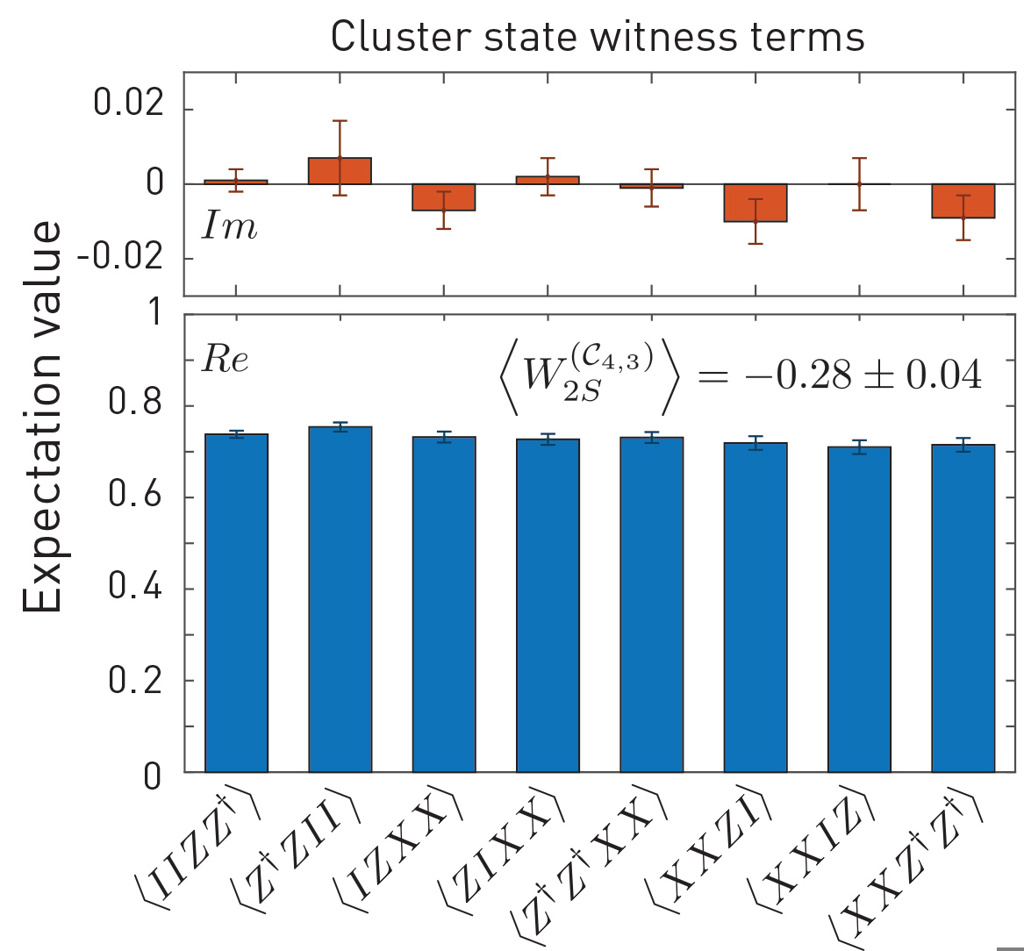 Schematic of the experimental setup for generating high-dimensional cluster states.
Schematic of the experimental setup for generating high-dimensional cluster states.
 Individual measured terms of the cluster state witness, confirming that the state is close to an ideal four-partite three-level cluster state.
Individual measured terms of the cluster state witness, confirming that the state is close to an ideal four-partite three-level cluster state.
The ultimate challenge in quantum science lies in developing efficient systems to provide the large information content required to solve meaningful problems faster than classical computers. In one widely adopted approach, gate-based quantum computation, state generation is relatively simple but processing is very challenging. The other main approach, one-way (or measurement-based) quantum computing, greatly simplifies algorithm implementation, but requires very complex systems—so-called cluster states.1
Photonics is particularly suited for one-way computing, but the realization of discrete cluster states has thus far been limited to qubits,2 which significantly limits both computational power and the accessible algorithms. A more efficient solution would be to exploit high-dimensional (d-level) systems. Unfortunately, to date, quantum systems based on ion traps, superconducting circuits and other platforms have not been able to produce the resources required for d-level multipartite systems of any form, which are essential for high-dimensional quantum computation.
In recent work,3,4 we have demonstrated the first realization of high-dimensional cluster states, using a remarkably accessible photonic system that exploits the simultaneous entanglement (hyper-entanglement) of two photons in their time and frequency domains. Via spontaneous four-wave mixing in an integrated nonlinear microcavity, excited by several laser pulses, photons were created in a coherent superposition of multiple time and frequency modes (three each). This led to a multi-partite state without increasing the number of physical photons.
To transform the resulting hyper-entangled, still bi-separable state into a cluster state, we developed a deterministic phase gate based on a frequency-to-time mapping scheme, which gave experimental access to individual terms of the generated wave function. We confirmed the realization of the high-dimensional cluster state by measuring a negative expectation value of a newly-developed multipartite cluster witness.5 The tolerance of the qudit cluster state toward white noise proved higher than that of a qubit cluster state with similar Hilbert space size. Finally, we demonstrated proof-of-concept high-dimensional one-way quantum computing operations, via projection measurements in the time or frequency domain.
Our approach, based on integrated-photonic chips and off-the-shelf optical fiber communication components, has achieved new and deterministic functionalities. We believe the work provides an important step towards reaching powerful, noise-tolerant quantum computation in a scalable and mass-producible platform.
Researchers
Michael Kues, Christian Reimer, Stefania Sciara, Piotr Roztocki, Mehedi Islam, Luis Romero Cortés, Yanbing Zhang, Bennet Fischer, José Azaña and Roberto Morandotti, Institut National de la Recherche Scientifique (INRS-EMT), Varennes, Canada
Sébastien Loranger and Raman Kashyap, Polytechnique Montreal, Montreal, Canada
Alfonso Cino, University of Palermo, Palermo, Italy
Sai T. Chu, City University of Hong Kong, Hong Kong
Brent E. Little, Xi’an Institute of Optics and Precision Mechanics, Chinese Academy of Science, Xi’an, China
David J. Moss, Swinburne University of Technology, Hawthorn, Victoria, Australia
Lucia Caspani, University of Strathclyde, Glasgow, U.K.
William J. Munro, NTT Corporation, Kanagawa, Japan
References
1. R. Raussendorf et al. Phys. Rev. Lett. 86, 5188 (2001).
2. P. Walther et al. Nature 434, 169 (2005).
3. C. Reimer et al. Nat. Phys. 15, 148 (2019).
4. M. Kues et al. Nat. Photon. 13, 170 (2019).
5. S. Sciara et al. Phys. Rev. Lett. 122, 120501 (2019).

